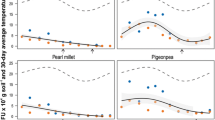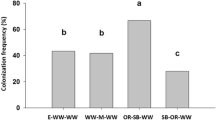Abstract
Data from surveys of winter wheat fields in the period 1974–1986 and of seed lots in the period 1962–1986 and identifications of diseases on plant samples were compiled to describe the occurrence of snow mould (Monographella nivalis) andFusarium spp. On average,M. nivalis dominated overFusarium spp. The complex ofFusarium spp. constituted mainly ofF. culmorum, followed byF. avenaceum andF. graminearum. M. nivalis was dominant in May on stem-bases and in July on leaves and leaf sheaths. On seedsM. nivalis predominated only in years with low temperatures in July and August.
Average brown footrot infection in the field was 4% tillers in May and 5% culms in July. Brown footrot intensity in July was high in cropping seasons with high precipitation in October and with low temperatures in October, November and December. In July during the early eighties, an average of 8% of leaves and 6% of flag leaf sheaths were infected byM. nivalis. Average ear blight incidence was 1.2% glumes infected. Seed contamination by these pathogens averaged 16% in the years 1962–1986. The contamination was high in years with high precipitation in June, July and August. Aspects of cv. resistance and yield loss are illustrated.
Similar content being viewed by others
References
Ahrens, W. & Fehrmann, H., 1984. Weizenbefall durchSeptoria nodorum und Ährenfusariosen. 1. Schadenanalyse. Zeitschrift fur Pflanzenkrankheiten und Pflanzenschutz 91: 42–58.
Al-Hashimi, M.H. & Perry, D.A., 1986. Survival and saprobic ability ofMonographella nivalis in soil. Transactions of the British Mycological Society 86: 373–379.
Andres, H., Hindorf, H., Fehrmann, H. & Träger-Born, J., 1987. Untersuchungen zum Auftreten und zur Verbreitung vonTyphula-Arten an Wintergetreide im östlichen Franken und Bayrischen Wald. Zeitschrift für Pflanzenkrankheiten und Pflanzenschutz 94: 491–499.
Bennett, F.T., 1928. On two species ofFusarium, F. culmorum andF. avenaceum, as parasites of cereals. Annals of Applied Biology, 15: 213–244.
Cassell, D. & Hering, T.F., 1982. The effect of water potential on soil-borne diseases of wheat seedlings. Annals of Applied Biology 101: 367–375.
Clarkson, J.D.S. & Polley, R.W., 1981. Assessment of losses caused by stem-base and root diseases in cereals. Proceedings 1981 British Crop Protection Conference on Pests and Diseases: 223–231.
Cook, R.J., 1981,Fusarium diseases of wheat and other small grains in North America. In: P.E. Nelson; T.A. Tousson and R.J. Cook (eds),Fusarium: Biology and Taxonomy. Pennsylvania State University Press. 39–52.
Daamen, R.A., 1981. Surveys of diseases and pests of winter wheat in the Netherlands, 1979–1980. Mededelingen Faculteit Landbouwwetenschappen Rijksuniversiteit Gent 46: 933–937.
Daamen, R.A. & Stol, W., 1990. Surveys of cereal diseases and pests in the Netherlands. 2. Stem-base diseases in winter wheat fields. Netherlands Journal of Plant Pathology 96: 251–260.
Daamen, R.A., Wijnands, F.G. & Vliet, G. van der, 1988. Disease and pest development in different winter barley cropping systems. In: M.L. Jorna and L.A.J. Slootmaker (Eds), Cereal breeding related to integrated cereal production, 38–43. PUDOC, Wageningen.
Daamen, R.A., Wijnands, F.H. & Vliet, G. van der, 1989. Epidemics of diseases and pests of winter wheat at different levels of agrochemical input. Journal of Phytopathology 125: 305–319.
Duben, J. & Fehrmann, H., 1979. Vorkommen und Pathogenität vonFusarium-Arten an Winterweizen in der Bundesrepublik Deutschland. 1. Artenspektrum und jahreszeitliche Sukzession an der Halmbasis. Zeitschrift für Pflanzenkrankheiten und Pflanzenschutz 86:638–652.
Ellen, J. & Langerak, C.J., 1987. Effects of plant density and nitrogen fertilization in winter wheat (Triticum aestivum). 2. Incidence ofGerlachia nivalis andFusarium spp. related to yield losses. Netherlands Journal of Agricultural Science 35: 155–162.
Forrer, H.R., Rijsdijk, F.H. & Zadoks, J.C., 1982. Can mildew assist the entry ofFusarium fungi into wheat leaves? Netherlands Journal of Plant Pathology 88: 123–125.
Häni, F., 1981. Zur Biologie und Bekämpfung von Fusariosen bei Weizen und Roggen. Phytopathologische Zeitschrift 100: 44–87.
Hewett, P.D., 1983. Seed-borneGerlachia nivalis (Fusarium nivale) and reduced establishment of winter wheat. Transactions of the British Mycological Society 80: 185–186.
Hoeven, E.P. van der & Bollen, G.J., 1980. Effect of benomyl on soil fungi associated with rye. 1. Effect on the incidence of sharp eyespot caused byRhizoctonia cerealis. Netherlands Journal of Plant Pathology 86: 163–180.
Jong, C. de., 1982. Bladaantasting doorGerlachia nivalis in wintertarwe. Doctoraal Verslag RUU, WCS and IPO. 112pp.
Lagneau, C., Dandois, J., Bastin, V., Poncelet, J. & Maraite, H., 1986. Evolution et sévérite des maladies sur froment d'hiver et escourgeon en 1985. Mededelingen Faculteit Landbouwwetenschappen Rijksuniversiteit Gent 51: 603–616.
Langerak, C.J., 1983. Annual report 1982/1983 of Government Seed Testing Station, Wageningen 35: 55–56.
Langerak, C.J. & Bollen, G.W., 1980. Annual report 1979/1981 of Government Seed Testing Station, Wageningen 31: 42–43.
Marin, J.P., 1986. Hongos asociados con el mal del pie del trigo en Andalucia occidental. Investigacion Agraria: Produccion y Proteccion Vegetales 1: 409–431.
Meunier, S., 1984. Inventaire des maladies du pied chez le froment d'hiver en 1983 et incidence sur les composantes du rendement. Parasitica 40: 27–40.
Meunier, S., 1985. Evaluation de l'importance des maladies du pied sur froment d'hiver en Belgique. Mededelingen Faculteit Landbouwwetenschappen Rijksuniversiteit Gent 50: 1125–1134.
Mielke, H., 1988. Untersuchungen überFusarium culmorum als Fuss-und Ährenkrankheitserreger beim Weizen. Mitteilungen aus der Biologischen Bundesanstalt für Land-und Forstwirtschaft Berlin-Dahlem. Heft 238. 101 pp.
Millar, C.S. & Colhoun, J., 1969.Fusarium diseases of cereals. VI. Epidemiology ofF. nivale on wheat. Transactions of the British Mycological Society 52: 195–204.
Snijders, C.H.A., 1990. Aspects of resistance to Fusarium head blight caused byFusarium culmorum in wheat. Dissertation, Agricultural University Wageningen, 115 pp.
Suttgon, J.C., 1982. Epidemiology of wheat head blight and maize ear rot caused byFusarium graminearum. Canadian Journal of Plant Pathology 4: 195–209.
Tanaka, T., Yamamoto, S., Hasegawa, A., Aoki, N., Besling, J. R., Sugiura, Y. & Ueno, Y., 1990. A survey of the natural occurrence ofFusarium mycotoxins, deoxynivalenol, nivalenol and zearalone, in cereals harvested in the Netherlands. Mycopathologia 110: 19–22.
Tempe, J. de, 1963. The blotter method for seed health testing. Proceedings of the International Seed Testing Association 28: 133–151.
Tempe, J. de & Limonard, T., 1967. Enkele aspecten van deFusarium, infective van tarwezaad. In: S. Broekhuuizen (Ed.), Collected papers on cereal diseases (1). Stichting Nederlands Graancentrum. Technisch Bericht no. 17, Wageningen. 35–42.
Tuyl, J.M. van 1977. Genetics of fungal resistance to systemic fungicides. Dissertation, Agricultural University, Wageningen. 137 pp.
Ubels, E., 1981.Fusarium in tarwe. Gewasbescherming 12: 105–124.
Ubels, E., 1984. Effecten van enkele zaadontsmettingsmiddelen en aarbescherming met een fungicide in wintertarwe uit zwaar metMonographella (Gerlachia) nivalis besmet zaaizaad. IPO rapport april 1984, Wageningen. 29 pp.
Ubels, E., & Vliet, G. van der, 1984a. Vatbaarheid van enkele tarwerassen voor aaraantasting doorFusarium culmorum enGerlachia nivalis. 1. Rassentoetsing door aarinfectie metF. culmorum. Gewasbescherming 15: 31–39.
Ubels, E. & Vliet, G. van der 1984b. Vatbaarheid van enkele tarwerassen voor aaraantasting doorFusarium culmorum enGerlachia nivalis. 2. Vergelijking van rasreacties opF. culmorum met die opG. nivalis. Gewasbescherming 15: 63–71.
Author information
Authors and Affiliations
Rights and permissions
About this article
Cite this article
Daamen, R.A., Langerak, C.J. & Stol, W. Surveys of cereal diseases and pests in the Netherlands. 3. Monographella nivalis and Fusarium spp. in winter wheat fields and seed lots. Netherlands Journal of Plant Pathology 97, 105–114 (1991). https://doi.org/10.1007/BF01974274
Accepted:
Issue Date:
DOI: https://doi.org/10.1007/BF01974274




